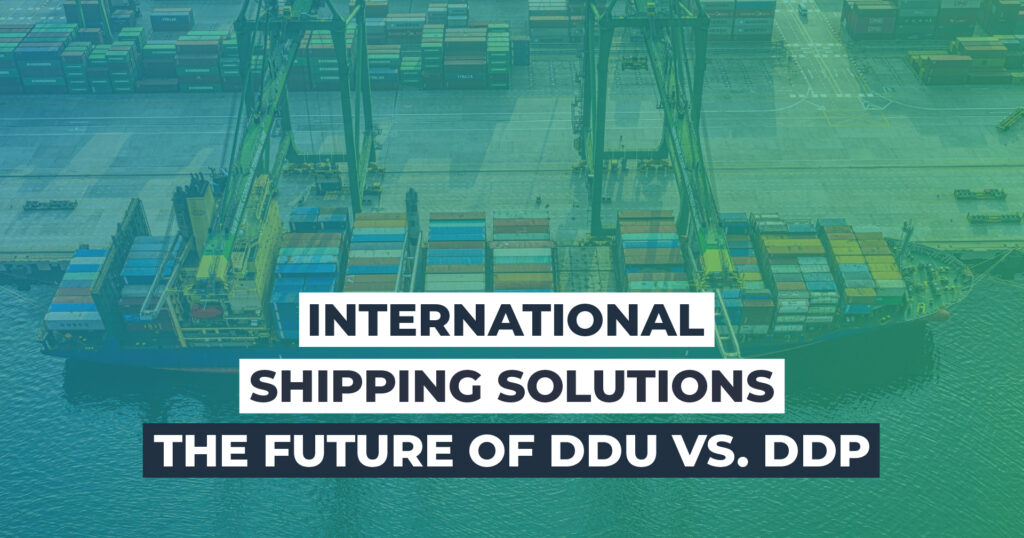If there is one thing that all ecommerce merchants have in common, it’s the sentiment that taxes can be stressful. Figuring those out state by state, and even more granularly city by city, can be a massive challenge that every entrepreneur must overcome at the beginning of their journey. However, if that ecommerce brand wants to start selling internationally, then the obstacles only multiply because of international duties and tariffs.
With every country having its own regulations and standards for what can be taxed and by how much, there is a lot of math to be done as ecommerce merchants prepare to go global. One of the biggest moments for an ecommerce brand during this time is deciding whether or not to offer DDU or DDP shipments.
Younger ecommerce brands may wonder what DDU and DDP are. Seasoned businesses that are established but looking to expand abroad may know the answer, but wonder which is right for them. In this article we’ll explore the pros and cons of DDU vs. DDP and look at the future of these options as the ecommerce industry develops.
DDU
DDU stands for Delivery Duties Unpaid. What that means is that your ecommerce brand is not responsible for paying duties and tariffs when you ship internationally, the customer is.
Positives
The benefit of DDU comes down to two factors: cost and simplicity.
1.) Cost
Covering all duties and tariffs on your end can really add up. Either you take the hit entirely, which cuts down your margins, or you build some or all of those costs into your product price, which can deter conversions. By going with DDU, you are not inflating the prices of your products to cover international fees and you are not paying duties and tariffs. It is left up to the customer to pay them once an order reaches their door.
2.) Simplicity
In terms of simplicity, If your brand decides to ship internationally with a DDU policy then you can activate that option on your ecommerce site and through ShipMonk, counting on the carriers to bill clients and handle all customs and clearances. Basically, you as the merchant don’t have to get involved in advance. Just make sure you’ve given ShipMonk and the carrier everything they need to send a package and off it’ll go. Whatever duties and tariffs come after that, the carrier will calculate them and then charge the customer.
Negatives
The above are the main positives of DDU. Ironically, the negatives have to do with cost and complications.
1.) Cost
You may think that there are only benefits to DDU in terms of costs because you aren’t paying for them, the customer is. However, that is assuming the customer accepts those costs. Imagine you are shopping online and there is a product for $30 you are interested in. You like it, you deem it worth the $30 you’d be paying, you purchase it. But then when your product is delivered you are told by the carrier or post office that you need to pay another $15 in taxes. Some people may be willing to pay that because they covet the item or need it. But that’s a 50% increase on what you thought you’d be paying and there are many people who wouldn’t deem the product worth the $45 anymore. If that’s the case, they can refuse delivery, which leads to the other, bigger negative—the complications.
2.) Complications
In situations like the above example, if a customer decides they don’t want to pay the duties and tariffs on an order because the total is no longer a reasonable price for the product, one of three things happens.
Option A – If your ecommerce brand accepts returns in these situations, then you have to arrange with the carrier to have the order shipped back to your nearest warehouse or fulfillment center. Which, of course, also adds to cost but becomes a complicated process of changing hands and getting your goods back.
Option B – If your ecommerce brand does not accept returns for such situations, and your online policies clearly state this (which they need to if that will be your stance), the refusing customer will probably contact your support team and fill out a claim or ticket trying to fight this. That weighs on your support resources. If your support people cave to the request, then come the costs and complications of Option A. If your support staff stick with your online policies as they likely would in such a situation, then you’re dealing with an angry customer who will not purchase from you again and may spread negative reviews your support team will have to deal with.
- Again, if you plan on having an ecommerce policy that states once a customer purchases an item they are agreeing to pay costs associated with duties and tariffs, make sure your online store says that clearly.
Option C – If the customer is not happy that their claim has been refused they may contact their credit card company to have the transaction voided or challenged. If you have your policies clearly stated, the credit card company will likely side with the ecommerce merchant. However, you will probably have to handle the situation, and if the credit card company sides with you then you’re dealing with the negative backlash mentioned in Option B.
DDP
DDP stands for Delivery Duties Paid. What that means is that your ecommerce brand is paying and taking full responsibility for any and all duties and taxes that come with sending shipments to international customers.
Positives
The benefit of DDP comes down to two factors: peace of mind and customer satisfaction.
1.) Peace of Mind
One of the main reasons to ship DDP is to eliminate refusals upon delivery, which add costs whether it’s refunding a customer and handling return shipping or dealing with disputes. With DDP, all the costs have been taken care of up front and after that it’s just a matter of your fulfillment center packing and shipping out the order. Carriers will take over from there, your customers will get their orders—that’s how complicated delivery is, i.e. not at all.
2.) Customer Satisfaction
It’s hard to say what customers detest more, paying extra or inconvenience. Either way, that’s what they face with DDU, but not DDP. Customers get what they ordered at the price they first paid without any surprises—no need to dispute additional charges, no need to interact with a post office or a carrier to exchange currency for additional costs. At the end of the day, regardless of the product or service, the easier you make it for a customer to make a purchase the happier the customer AND the more likely the customer is to make that purchase.
Negatives
If you ship DDP then you are doing one of two things: you are either paying for all those duties yourself or you’re building them into the price of your product so your customers are paying for them (altogether or somewhat), but they don’t necessarily realize that as the fees are just included in the singular product price. Either way, you’re going to need to figure out what to charge. Which means DDP can weigh on an ecommerce merchant in the forms of research/setup, cost, and decreased conversions.
1.) Research/Setup
The first step to being a DDP global brand is knowing how much each country you ship to will charge in duties and tariffs. The first step to that is learning the de minimis. This is a set dollar, euro, peso, etc. amount, which is your country by country duties threshold. If your ecommerce brand sends a shipment that is below the de minimis then you don’t have to pay duties and tariffs when you export to other countries. If your product value is above the de minimis then you have to pay duties and taxes. The US has a very high de minimis of $800, so countries sending goods our way don’t have to pay taxes on imports unless they’re worth more than $800. Unfortunately, while the US has a very high de minimis, other countries have a very low de minimis.
There are a lot of reasons that the US has a high de minimis. A lot of it is due to sheer volume. If the US de minimis wasn’t so high, because the US imports A TON of things, then customs would have to evaluate and sort through A TON more items on a daily basis, which takes time and costs money.
Also, the US has a much more complicated internal tax structure. Since in the US taxes are stratified at the state and local level vs. in other countries where it’s just by the whole, the US already has a lot going on in terms of collections. Meanwhile other countries and continents, say Europe, have interwoven economies so they have no trouble charging a smaller duty or tariff that will apply to many more inbound shipments because they have the time and resources to sort through it. If the US had to determine import taxes and tariffs for each of the 50 states individually by having a lower de minimis, well . . . let’s not even think about that.
The overall takeaway is that if you’re going to ship DDP, you will need to get accurate duties and tariffs information for every country you plan on selling to, which starts with de minimis research. Do not proceed with DDP selling setup until this info has been acquired.
2.) Cost
Many ecommerce brands don’t find DDP financially feasible if they are absorbing all the costs of the duties and tariffs. If you don’t want to build in these costs to your product, and thus not potentially drive away customers who deem your products too expensive, then you have to take on these costs behind the scenes. That means lowering your profit margins, sometimes significantly. But if your profit margins aren’t high enough, then is there a point to selling internationally—is it more helping or hurting the growth of your ecommerce brand?
Part of this depends on the price of the product you set. You also have to take into account manufacturer costs and shipping costs, the latter of which vary by country as well. So, all in all, by taking on DDP without the margins to cushion it and large enough sales to support it, it can really hurt an ecommerce merchant.
3.) Decreased Conversions
Let’s say your ecommerce brand didn’t want to take on all the costs and lose so much of your profit? Well, there’s always the option of building the cost into the price of your products so that your customers are assuming those costs. That may protect your budget, but the problem is that with your product price driven up there are going to be fewer people willing to pay for it.
Think about it. In the minds of a consumer, when assessing value there is a difference between a sweater for $50 and a sweater for $75. There is a difference between a pair of shoes for $150 and a pair of shoes for $200. And there is a difference between a hairbrush for $20 and a hairbrush for $40. With every dollar added, people question whether the value equals the cost. So by building duties and tariffs into the price of your products you could be limiting your sales since not as many people are willing to pay higher prices.
The Future of DDU vs. DDP
As it stands, according to ShipMonk analysis, approximately 60% of our international clients utilize DDU over DDP, which reflects the general split of the industry that is two thirds DDU as well. The simple reason for this is to conserve costs and because there is a certain level of complexity to getting DDP right. However, the world seems to be moving to embrace DDP in the quest to make things as simple as possible for customers, courting more sales.
Our current ShipMonk experts predict that DDP is going to become more of a necessity as the years go on—ecommerce merchants being forced to handle duties and tariffs because we live in an era where customers are getting increasingly accustomed to getting things shipped overseas. Governments are also going to want companies to go more DDP because it costs them time and money to chase down every order recipient.
Hopefully, since wasting time and money is as annoying to governments as it is to companies, we’ll see reduced duties and tariffs, or higher de minimis values, or just more streamlined fees and rates from country to country to reduce complications. Because, let’s face it, no one—customer, company, country—wants to spend more or be lost in complexity. So with that in mind, perhaps one day all parties involved in ecommerce ordering can find a shared solution for this shared headache.
For more about shipping solutions, visit our Virtual Carrier Network article now. And be sure to check out ShipMonk’s locations page to see our international fulfillment centers available to you.





